The frequency of adverbs is not only an exercise in grammar; it’s a powerful tool that enables us to articulate our experiences easy. From always to never, these small but mighty words help paint a clear picture of our lives’ rhythms, allowing listeners or readers to grasp just how often we partake in certain actions. In this article, we will delve into the interesting world of adverbs of frequency exploring their usage in everyday language, and offering practical tips into your English vocabulary. Join us as we got on to this journey in the direction of greater quick and smooth talking.
What are Adverbs of Frequency?
Definition
Adverbs of frequency are very important for English language that help us convey an action occurs, adding a layer of precision to our communication. Commonly used adverbs such as always, sometimes, and never allow speakers to express routines and habits in a nuanced way. For instance, saying “I always drink coffee in the morning” not only indicates a habit but also invites listeners into the speaker’s daily ritual, fostering a connection based on shared experiences.
Examples of Frequency of Adverb
- Normally
- Usually
- Always
- Often
- Sometimes
- Occasionally
- Never
How Often?

| Never | 0% |
| Rarely | 5% |
| Seldom | 10% |
| Occasionally | 30% |
| Sometime | 50% |
| Often | 70% |
| Generally | 80% |
| Usually | 90% |
| Always | 100% |
Example Sentences
- She analyzes five product sheets weekly.
- She bakes cookies daily.
- I rarely see him in the ground.
- I usually got my morning walk missed.
- She goes to hospital daily.
- He often goes to the library.

Usage of Adverbs of Frequency
- To explain the number of times an activity happens
- To indicate the repetitive activities or routine
- Position the adverb of frequency in the middle of a sentence, before the verb and after the subject, if a sentence has only one verb.
- Position the adverb of frequency before the main verb, If a sentence has more than one verb.
- They are placed before the main verb in negative and interrogative sentences.
Position in sentence
- Before the main verb
- After the main verb
- Between the main verb and the helping verb
The Two Types of Adverbs of Frequency
When discussing adverbs of frequency, it’s recognize the two main types: definitive and indefinite. Definitive adverbs clearly specify how often an action occurs.
- He goes to school daily.
- They go to KFC weekly.
- She does groceries monthly.
- Our official dinners are held annually.
Indefinite adverbs provide a more flexible understanding of frequency by expressing generality rather than certainty.
- He usually finishes her tasks on time.
- He often goes to school early morning.
- He frequently goes for the morning walk.
- She usually goes to the academy.
Adverbs of Frequency List
- Annually
- Constantly
- Eventually
- Always
- Daily
- Ever
- Frequently
- Infrequently
- Generally
- Hourly
- Later
- Monthly
- Never
- Nightly
- Normally
- Next
- Now
- Often
- Quarterly
- Occasionally
- Rarely
- Yet
- Regularly
- Soon
- Then
- Sometimes
- Today
- Weekly
- Yearly
- Tonight
- Yesterday
Worksheet for Adverbs of Frequency
- 1-Indicate the Adverb of Frequency:
- A- Yearly
- B- Tonight
- C- Regularly
- D- All of these
- Right Answer: D
2- Which one is not the type of Adverb of Frequency?
- A- Adverb of Definite Frequency
- B- Adverb of Indefinite Frequency
- C- Regular Adverb of Frequency
- D- All of these
- Right Answer: C
3- Indicate the correct placement of the Adverb of Frequency.
- A- Before the main verb
- B- After the main verb
- C- Between the main verb and the auxiliary verb
- D- All of These
- Right Answer: D
FAQs
How to teach adverbs of frequency to beginners?
There are six main adverbs of frequency that we use in English: always, usually (or normally), often, sometimes, rarely, and never.
What are adverbs of manner?
Adverbs of manner describe how something happens. For example, it is possible to make a cake in different flavour.
What are adverbs of frequency?
An adverb of frequency is a word that is employed in a sentence to give more information about the verb, adjective or another adverb.
Conclusions
Adverbs of frequency play a crucial role in our daily communication, allowing us to express how often actions occur with clarity and precision. By using terms like always, usually, and never, we can convey not just the frequency of activities but also our attitudes toward them. These adverbs help us to paint a vivid picture of our routines and habits, making conversations more engaging and informative. As you continue to enhance your language skills.
